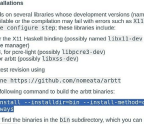Getting to grips with breadboards

One of the best things about Raspberry Pi or Arduino single-board computers (SBC), or similar, is that they provide a GPIO (general purpose input/output) facility that enables them to be connected to external devices. This offers the opportunity to learn about embedded computing and, once you’re up to speed, use your SBC in so many exciting projects. Usually, though, you can’t attach those external devices to pins on the GPIO. Instead, it’ll be necessary to use some simple interfacing circuitry.
Without some experience of electronics this might sound daunting for a couple of reasons. First, it won’t be immediately obvious what arrangement of components is needed. Even if you’re presented with a circuit diagram, it might not be easy to convert that schematic into a real-world assembly of components that you can attach to your single board computer. It’s that second issue that we address here by providing an introductory guide to building circuits on so-called breadboards. Why the word breadboard? It’s because at one time electronics engineers used real wooden boards (even using actual dime-store breadboards) for prototyping circuits, using wood screws as binding posts.
Breadboard benefits
The traditional way of building electronic circuits involves soldering them together. That’s exactly how the motherboard in your PC will have been manufactured, but it’s built on a PCB (printed circuit board) which you’re not going to want to design until you’re certain that your circuit works as intended. An option that’s more suitable during the prototyping and testing phase is to use a stripboard, but it still involves soldering, for which
You’re reading a preview, subscribe to read more.
Start your free 30 days





